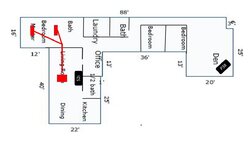I have a Harmon invincible rs pellet stove, it heats our two story house well, the only downfall is there was a new addition added to the house years ago before we bought it, the original house is brick so there is only one door way to the new addition, the secondary heat is hot water baseboard heated from a propane boiler, we've been able to heat the up and downstairs with only the pellet stove, we heat the addition with the baseboard. my goal this winter is to get heat from the stove to the new addition and use less of the propane or none at all, the plan is to put a floor register in by the stove run the duct work through the basement into the crawl space under the new addition and branch off into floor registers. I will install booster fan in the duct work, the run would be about 30 ft from the stove to the new addition, i want to get some input on this to see if im in the right direction, i was thinking about using 5 or 6 inch round ducting.





